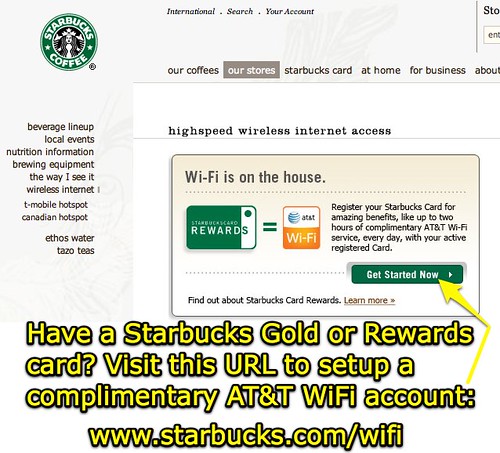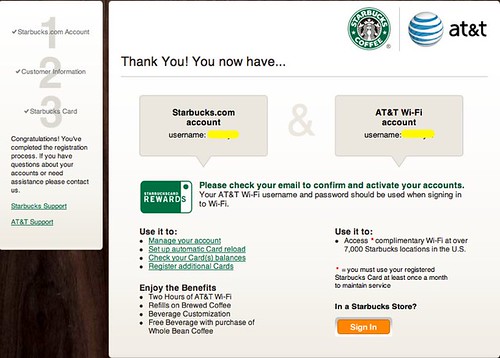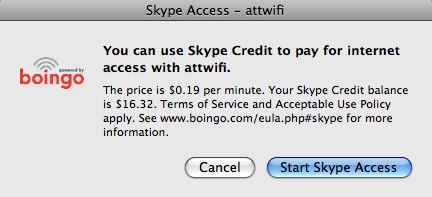My wife is a much more regular coffee drinker than I am, so it seems a bit ironic I was the first person in our family to purchase a “Starbucks Gold card.”
The card can be used as a gift/money card for Starbucks coffee and gives you a 10% discount on purchases, but the feature which really sold me was getting 2 hours of free AT&T WiFi access per day from any AT&T hotspot. It costs $25 per year. I’m finding myself on the road more these days, and although I still am paying a steep price for an AT&T 3G laptop card, it can be faster and handier to connect via WiFi when working online. 3G cell phone network coverage is still pretty sparse here in the midwest, too, so I think it will come in handy to have an option to connect when I need to using AT&T Hotspots. They’re not just available in Starbucks, these days, many McDonalds stores offer AT&T WiFi. Free and fast WiFi is the best option, of course, in places like Panera or Java Daves here in the OKC metro area, but sometimes free WiFi isn’t available or an option at other locations. It helps to have different connectivity choices. Sadly, “connectivity choices” are not a reality for many folks today in rural areas. Those of us living in urban centers have it relatively good from a bandwidth availability standpoint.
Yesterday, I spent at least 30 minutes searching (unsuccessfully) for the website to “register for a complimentary AT&T WiFi account” which I could use with my Starbucks Gold Card. I obtained the URL today by calling the Starbucks 1-800 number. (1-800-STARBUC) For some reason (at this point) this URL is NOT provided on either the Starbucks Gold Card site (including the FAQ page, which requires a login to view) or the AT&T WiFi splash page at Starbucks. The needed URL to setup this “complimentary AT&T WiFi account” is:
After completing the straightforward signup process, my Starbucks login now serves as my AT&T WiFi login credentials.
I do have an iPhone, and AT&T provides free WiFi access FOR YOUR iPHONE ONLY at Starbucks locations. Unlike the Blackberry, however, you cannot “tether” a laptop at present to an Internet-connected iPhone (via EDGE, 3G or WiFi) to get online via the laptop. Jailbroken iPhones can utilize the program “Modem” to tether an iPhone to a laptop for shared Internet connectivity, but an application with this functionality is not available on the official iTunes App Store.
You might be surprised that I don’t have AT&T DSL or UVerse at home since I spent two years working for AT&T. If I had home Internet service from AT&T, I’d be able to use my AT&T-provided email address to login for free WiFi access at AT&T hotspots. Unfortunately, our home is located in a “dry spot” for AT&T Internet service. We can’t get either DSL or Uverse at our house, so I’m on Cox Cable. It’s fast and reliable, and I have no complaints, but it doesn’t help with providing free WiFi options when I’m out and about.
Now that I installed Growl on my Macbook, I’m seeing new notifications for different applications including Skype and Nambu. Since I had Skype running here at Starbucks along with Growl (I think) I was prompted with the following message before I finally got logged into my “complimentary AT&T WiFi” account:
19¢ per minute for Wifi access?! Ouch! That might be a good deal in a country like New Zealand (where public WiFi seems pretty costly,) but here in the U.S. it seems pretty steep.
I’m honestly not sure if this message was shown thanks to Growl, or if I would have seen it just by having Skype open on my computer before I was authenticated to the AT&T WiFi hotspot. I suspect the latter may be the case. In either event, this seems like a comparatively costly WiFi connectivity option, although it might be handy for someone with lots of existing Skype credits.
It is absolutely essential we work in our communities, advocating at state and federal levels for the rapid buildout of affordable broadband Internet connectivity options, particularly in our rural and underserved areas. I’m glad to see more discussion on the Broadband over Power Line (BPL) systems in the media. I reflected about this a bit in a birthday post in 2008, “Railroads and virtual connections.” The FCC’s page on BPL has relatively little information about this technology option compared to the current English WikiPedia article for “Power line communication.” According to Saul Hancell’s February 29, 2009, article in the New York Times, “I.B.M. Delivers Rural Broadband Over Power Lines” this technology works, is available, and is more realistic than ever given newly announced federal stimulus subsidies for rural broadband initiatives. Saul wrote:
To deploy a broadband system, a power company needs to run an Internet connection over fiber to each electrical substation. Then it can simply install one amplifier per mile of power line. Another device sends the signal the final stretch to subscribers’ homes. To use the service, consumers can plug the modem into any outlet. With the amplifiers, the signal can be sent 25 miles from a substation, far longer than DSL service over phone wires.
Mr. Blair said this technology has been cost-effective in areas that have 5 to 15 customers near each mile of line. The government grants might even encourage power companies to install it in even more sparsely populated areas.
We CANNOT wait for commercial Internet providers, like AT&T, Verizon, and others, to bring high-speed Internet connectivity to rural America based on return-on-investment (ROI) calculations. These companies have not brought those services to rural America because it is not comparably profitable to do so as it is in urban population centers. When we electrified our nation in the 1930s, we did not wait for behemoth mega-corporations to conduct ROI studies, and then “get back to us with their decision.” No, we formed a variety of utility cooperatives and utilized government subsidies to get our entire nation electrified. Organizations like the Tennessee Valley Authority were created and maintained to provide electricity as well as other services in areas where businesses and corporations wouldn’t do it. The same thing needs to happen today with rural broadband connectivity. The 2006 Tennessee Taskforce on rural broadband deployment’s observations were and are exactly on target in this regard:
“Rural electrification [in the United States] was achieved only after a coordinated effort by the public and private sectors, which succeeded in driving full deployment and adoption of that technology to farms and small towns across the country,” the report stated. “Widespread deployment and adoption of broadband also will require a coordinated effort by the public and private sectors.”
Our assumptions of what is normal, expected, and standard for “high speed” Internet in the United States are in need of a MAJOR shift. Compared to parts of east Asia and Europe, our “high speed” connections are excruciatingly slow. Telecommunications companies are not going to “fix” this problem on their own.
The March 29, 2009, editorial in The Oklahoman newspaper, “By the numbers: AT&T makes good on spending pledge,” merely quotes AT&T claims that “Broadband Internet access has been greatly expanded” in our state rather than citing actual statistics showing broadband penetration today and how it’s changed over time. My experiences accessing the web in rural Oklahoma suggest we have a LONG way to go before high speed connectivity is the norm rather than the exception in our state.
Bring on the fiber. Let’s light it up.
Technorati Tags:
wifi, starbucks, att, connectivity, broadband, rural, fcc, gold, card, fiber, bandwidth
If you enjoyed this post and found it useful, subscribe to Wes’ free newsletter. Check out Wes’ video tutorial library, “Playing with Media.” Information about more ways to learn with Dr. Wesley Fryer are available on wesfryer.com/after.
On this day..
- Arab Spring and the 2018 Oklahoma Teacher Walkout – 2018
- Lessons Learned on our Family’s College Journey (April 2016) – 2016
- Oklahoma SDE Providing Funds for 1 Year Common Core Coach Positions – 2012
- Technology Trends in Higher Education (April 2010) – 2010
- VLE versus MLE – 2008
- links for 2008-04-09 – 2008
- Choosing forgiveness and grace over hate and revenge – 2007
- Promoting blogosphere civility – 2007
- The landscape of commercial eLearning curriculum options – 2007
- Flash format screencasts – 2007






Comments
2 responses to “WiFi Connectivity Options at Starbucks, AT&T hotspots, and Rural Broadband over Power Lines”
You can get the 2 hours of free wifi with the normal starbucks card: https://www.starbucks.com/card that doesn’t require the $25 annual fee.
In regard to broadband, why aren’t you using AT&T’s wireless broadband service? I think their coverage area extends in your area.
It’s also not really comparing apples to apples when looking at the electrical grid and broadband. There are different broadband technology – fiber, DSL, cable, wireless 3G, WiMax just to name a few. Which one do you subsidize? Your claim that it’s not affordable to build out broadband around a traditional ROI model is based on a fiber model – not next generation wireless systems like WiMax that are cheaper to deploy. Look at developing nations – they’re not building out traditional phone lines but leapfrogging that technology with cell towers.
And you could build an attractive ROI model for rural areas if the public entities in those communities came together to aggregate their broadband needs. This sort of “community based networking” helps show providers that there will be sufficient enough demand/usage to justify the costs of building out the service. Instead, what usually happens is that schools try to buy their own broadband. Hospitals do their own bids. Libraries go out on their own. That’s part of the reason why the broadband stimulus dollars are targeted toward these aggregated demand projects
Rural broadband activists and technologists RidgeviewTel have a website where people in unserved or underserved rural communities can register and aggregate their need for broadband to help attract service / stimulus dollars.
Visit WeNeedBroadband.com or call 866-992-WNBB and find us on Twitter at @ruralbroadband!